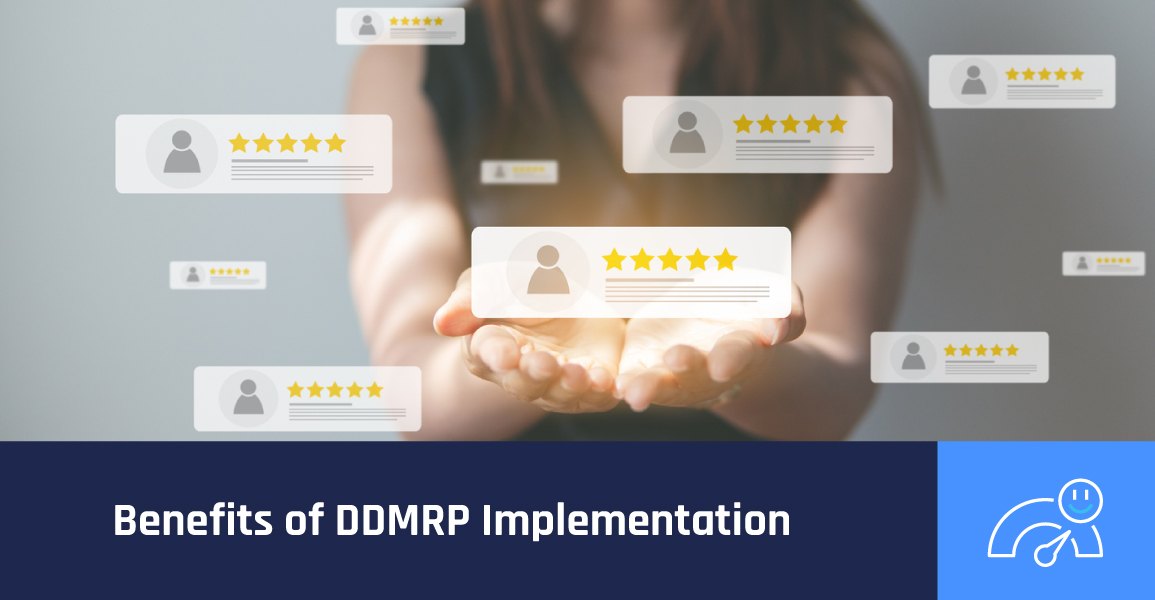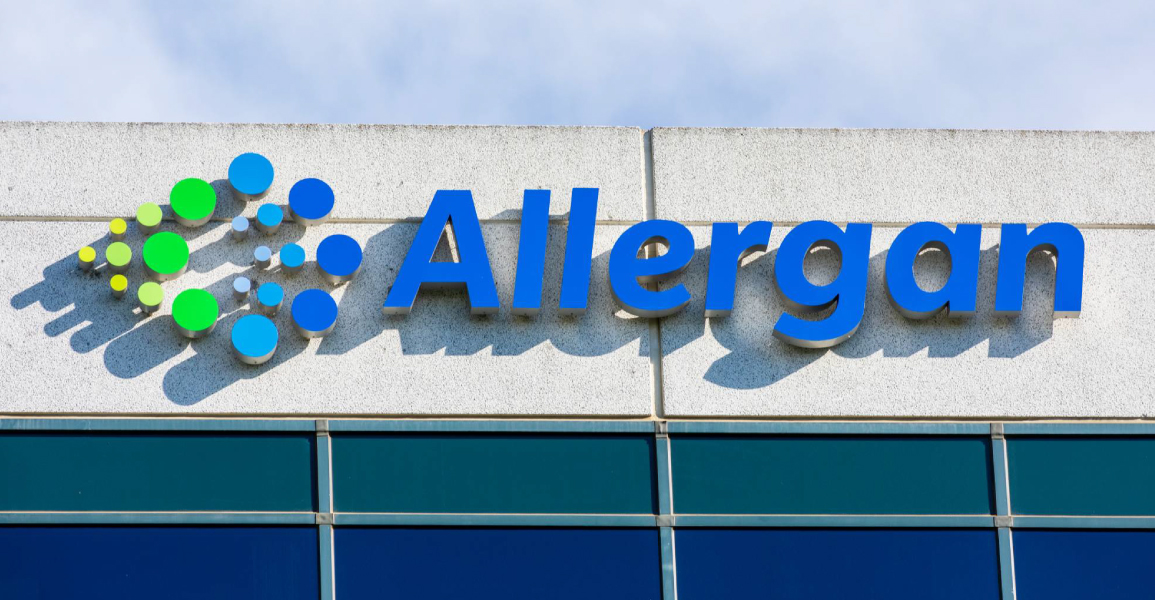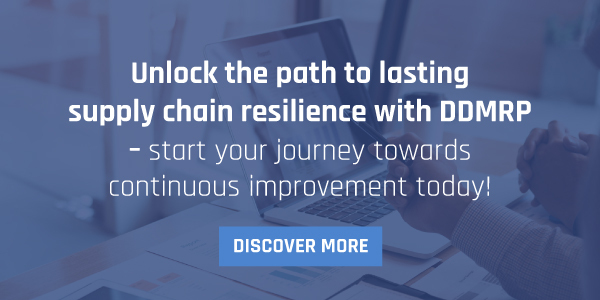
Harmony in Motion: How DDMRP Drives the Symbiosis of Agility and Sustainability
March 29, 2024
Navigating Market Dynamics: Building Resilient Supply Chains with Real-Time Demand Insights
April 29, 2024In an era marked by rapid technological advancements, volatile market conditions, and unpredictable consumer behaviours, traditional supply chain management approaches are proving increasingly inadequate. The conventional, forecast-driven models often fall short in meeting the demands of today’s dynamic marketplace. In response, businesses are turning towards innovative methodologies to navigate this complexity and achieve supply chain excellence. One such approach gaining traction is Demand-Driven Material Requirements Planning (DDMRP). This article explores the transformative potential of DDMRP in shifting from traditional to proactive supply chain strategies, enabling businesses to anticipate and respond to real demand dynamically.
Understanding the Limitations of Traditional Supply Chain Management
Traditional supply chain management practices have long leaned heavily on historical data and forecasting methods to anticipate future demand. While these approaches have been the cornerstone of many businesses’ strategies, they often falter in the face of the dynamic and unpredictable nature of today’s markets. Unforeseen disruptions, such as natural disasters or geopolitical events, can swiftly derail carefully laid plans. Similarly, sudden shifts in consumer preferences driven by evolving trends or competitive actions can catch businesses off guard.
The limitations of traditional supply chain management become particularly evident during periods of market volatility. Fluctuations in demand, supply chain disruptions, or changes in economic conditions can lead to imbalances in inventory levels. Businesses may find themselves with excess stock that ties up capital and warehouse space or facing stock outs that result in lost sales opportunities and dissatisfied customers.
Moreover, increased lead times compound these challenges, further exacerbating the strain on supply chain efficiency. Longer lead times can delay the replenishment of inventory, leading to extended wait times for customers and potentially eroding brand loyalty.
Ultimately, the shortcomings of traditional supply chain management practices manifest in decreased customer satisfaction and reduced profitability. Customers expect products to be available when and where they need them, and any deviation from this expectation can tarnish a company’s reputation and bottom line.
In light of these limitations, businesses are increasingly turning to innovative approaches such as Demand-Driven Material Requirements Planning (DDMRP) to overcome the shortcomings of traditional supply chain management and adapt to the realities of today’s marketplace.
The Emergence of DDMRP: A Paradigm Shift in Supply Chain Dynamics
Demand-Driven Material Requirements Planning (DDMRP) marks a significant departure from traditional supply chain management methodologies, heralding a paradigm shift in how businesses approach inventory management and planning. Unlike conventional approaches that rely heavily on forecast accuracy to predict future demand, DDMRP prioritises responsiveness and agility.
At the heart of DDMRP lies the fundamental principle of synchronising inventory levels with real-time demand signals. By moving away from static safety stocks and instead aligning inventory with actual customer needs, businesses can better adapt to dynamic market conditions and minimise the risks associated with inaccurate predictions.

The core principles of DDMRP are structured to promote efficiency and responsiveness through the following components:
- Strategic Decoupling- The cornerstone of DDMRP is the strategic placement of decoupling points within the supply chain. These points act as buffers that protect the system against fluctuations in demand and supply disruptions. The selection of these decoupling points is critical as they directly influence customer lead times and the level of inventory investment required. DDMRP utilises six criteria to determine the optimal locations for these decoupling points, ensuring that each point serves as an effective firewall against variability in both supply and demand.
- Buffer Profiles and Levels- Once decoupling points are established, DDMRP requires the creation of buffer profiles for each decoupled item. These profiles are essential for managing inventory levels effectively, ensuring that buffers are appropriately sized to maintain the decoupling intent. Buffer profiles take into account various attributes such as lead time, product structure tier, and susceptibility to supply and demand variability. This systematic approach facilitates easier management and oversight of inventory across multiple items and locations.
- Dynamic Buffer Adjustments- Recognizing the dynamic nature of the modern business environment, DDMRP incorporates flexibility in buffer management. Dynamic buffer adjustments allow the system to adapt to changes in demand rates, lead times, and other pertinent item properties. Adjustments are also made in anticipation of planned events like promotions or seasonal fluctuations. This adaptability is typically supported by DDMRP-compliant systems through automated recalibrations of buffer sizes and positions.
- Demand Driven Planning- At the operational level, DDMRP applies a set of unique supply order generation rules, known as the net flow equation, to the configured model. This process, conducted frequently (often daily), ensures that supply orders are generated in accordance with real-time demand and inventory status at each decoupling point. The resulting orders prompt a decoupled explosion process, where dependent demand cascades down to the next buffer position, maintaining the integrity of the supply chain.
- Visible and Collaborative Execution- DDMRP distinguishes clearly between planning and execution phases. Once a supply order is approved and scheduled, the execution phase begins, managed through a system of alerts that include Buffer Status Alerts and Synchronisation Alerts. These alerts are crucial for identifying and resolving flow blockages that could impact delivery schedules or buffer status, thereby maintaining the smooth operation of the supply chain.
- Tactical Adaptation- The final principle of DDMRP revolves around the continuous adaptation and refinement of the system based on performance feedback and future expectations. This process is embodied in the Demand Driven Sales and Operations Planning (DDS&OP) cycle, which periodically adjusts the DDMRP settings (Master Settings) to align with observed results and projected needs. Unlike traditional models, DDS&OP moves away from a fixed master production schedule, opting instead for a more flexible and responsive framework.
Through these principles, DDMRP provides a robust framework for companies to become more agile and responsive to market changes, effectively transforming traditional, forecast-driven supply chains into dynamic, demand-driven systems.
Benefits of DDMRP Implementation
The implementation of Demand-Driven Material Requirements Planning (DDMRP) offers a multitude of benefits to businesses seeking to revolutionise their supply chain management practices. From enhanced agility to improved customer satisfaction, DDMRP brings about transformative changes that drive efficiency, responsiveness, and competitiveness.
- Enhanced Agility- Embracing a demand-driven approach through Demand-Driven Material Requirements Planning (DDMRP) equips businesses with exceptional agility and responsiveness in navigating market fluctuations. With DDMRP, organisations gain real-time visibility into demand signals, allowing them to promptly adjust to shifting customer needs and preferences. This proactive stance enables companies to pivot their production and distribution strategies in sync with changing market dynamics, positioning them to outmanoeuvre competitors.
By leveraging DDMRP’s capabilities, businesses can swiftly reallocate resources, adjust inventory levels, and optimise supply chain processes to meet evolving demand patterns. This agility not only enables organisations to respond rapidly to market changes but also allows them to anticipate trends and capitalise on emerging opportunities. Ultimately, DDMRP empowers businesses to stay agile and adaptable in the face of uncertainty, ensuring they remain competitive and resilient in today’s fast-paced business environment.

- Optimal Inventory Levels- The implementation of Demand-Driven Material Requirements Planning (DDMRP) brings a strategic advantage through the optimization of inventory levels, addressing common pitfalls of traditional supply chain models such as overstocking or frequent stockouts. These traditional issues not only tie up capital but also impact profitability due to increased carrying costs and missed sales opportunities. DDMRP counters these challenges by enabling businesses to synchronise their inventory levels with actual demand patterns.
Through strategic placement of inventory at key locations and the dynamic adjustment of buffer sizes, DDMRP allows organisations to maintain optimal inventory levels—enough to meet demand without surplus. This careful balancing act reduces unnecessary stock, decreases carrying costs, and enhances inventory turnover rates, which in turn optimises financial performance. Moreover, the efficiency gained from this optimization streamlines operations and liberates capital for investment in other strategic areas, such as innovation or market expansion. By adopting DDMRP, businesses can achieve a leaner, more responsive supply chain that not only meets customer demand more effectively but also boosts overall operational agility and competitiveness.
- Reduced Lead Times- Reduced lead times are a significant benefit of implementing Demand-Driven Material Requirements Planning (DDMRP), addressing a critical weakness in traditional supply chain models characterised by prolonged delays that introduce inefficiencies and hinder responsiveness. DDMRP directly combats these issues by enabling more proactive inventory management. By reducing reliance on static planning parameters and shifting towards a demand-driven system, businesses can significantly streamline their procurement and production workflows. This agile approach allows for a faster movement of materials and products throughout the supply chain, thereby cutting down overall lead times.
- Improved Customer Satisfaction- Improved customer satisfaction lies at the core of Demand-Driven Material Requirements Planning (DDMRP). This methodology significantly enhances the customer experience by ensuring higher product availability and drastically reducing the occurrences of stockouts. Such reliability in fulfilling customer demands not only solidifies customer trust but also builds brand loyalty and advocacy. By implementing DDMRP, businesses can more effectively meet customer expectations, consistently deliver on their service promises, and thus, improve customer retention rates.
Furthermore, DDMRP allows businesses to proactively anticipate and respond to customer needs and preferences, which is vital in today’s fast-paced market environments. This proactive approach ensures that organisations can adapt swiftly to changes in demand without compromising on service quality or efficiency. As a result, businesses are seen as dependable and responsive, qualities that elevate their brand reputation and make them preferred partners in the eyes of both existing and potential customers. By leveraging DDMRP, companies not only enhance their operational capabilities but also strengthen their competitive position in the marketplace, setting a foundation for long-term success and customer-centric growth.
Case Study: How Patrick Rigoni helped Allergan
Under the guidance of Patrick Rigoni, Allergan, a prominent player in the biotech and pharmaceutical sector, embarked on a transformative journey to revamp its supply chain strategies. Faced with the challenges of high inventory levels, extended lead times, and inconsistent service levels, Allergan recognized the imperative need for a more agile and responsive supply chain to navigate through significant mergers and market pressures. In 2014, Allergan initiated a pilot program in its European Logistics & Planning centre to implement DDMRP, with a focus on real-time demand sensing, supply chain stabilisation, and planning process simplification.
Through meticulous planning and execution, Allergan achieved remarkable results. The implementation of DDMRP led to a significant reduction in inventory levels, surpassing 30%, thereby freeing up capital and reducing holding costs. Furthermore, lead times to the distribution network were slashed by more than 50%, enabling Allergan to respond faster to market demands and enhance its competitive edge. Despite these improvements, service levels remained consistently above 99%, signifying enhanced customer satisfaction and trust.

The success of Allergan’s pilot program underscores the transformative potential of DDMRP in optimising supply chain performance, especially in industries characterised by volatility and complexity, such as biotech and pharmaceuticals. Allergan’s experience serves as a testament to the effectiveness of DDMRP in addressing the inherent challenges of modern supply chains, providing a blueprint for other companies seeking to enhance their operational efficiency and navigate market uncertainties with confidence.
Conclusion: Embracing the Future of Supply Chain Management
In today’s fast-paced business environment, the ability to anticipate and respond to real demand dynamically is essential for maintaining a competitive edge. Demand-Driven Material Requirements Planning (DDMRP) offers a powerful framework for businesses to achieve demand-driven excellence and transform their supply chain operations. By embracing proactive inventory management, decoupling material and information flows, and optimising buffer levels, organisations can enhance agility, reduce lead times, and improve overall customer satisfaction. As businesses continue to navigate the complexities of the modern marketplace, DDMRP stands out as a proven strategy for driving operational efficiency, mitigating risks, and unlocking new opportunities for growth.
Ready to harness the power of DDMRP? Contact us for personalised guidance today.





